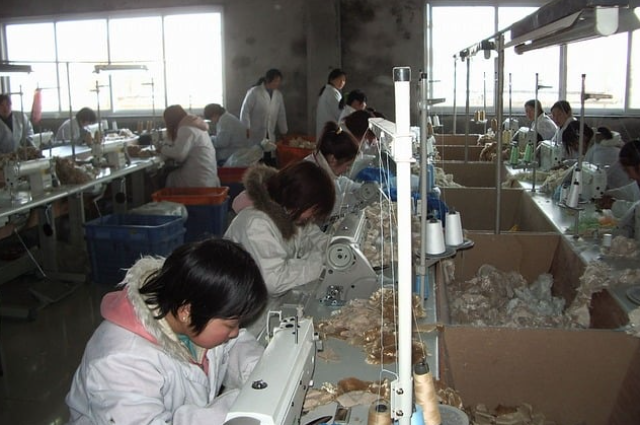
Image by PublicDomainPictures from Pixabay
Ever drooled over a $4,000 Chanel bag on Instagram, only to find out it’s stitched in the same Chinese sweatshop as a $300 lookalike? Mic drop. Or imagine a grandma in an Indian village pouring her heart into a khadi kurta with chikankari swirls, just for it to sell for thousands in Paris while she’s tossing coins in a jar. Welcome to the wild, shady circus of global fashion, where price tags are a scam and the real MVPs get zero love. This is the saga of China blowing the lid off America’s luxury con and India’s textile geniuses getting stiffed. Why should you, the young, give a rip? Because you’re either wearing or craving something tied to this drama, and it’s time to spill the tea on who’s cashing checks and who’s eating dust.
First stop: China, the factory king that’s done playing the US’s fool. In 2025, with trade wars spicier than chili oil, Chinese workers started clowning on X, outing the wholesalers pumping out “designer” gear for Gucci, Adidas, and Burberry. A post from @FactoryTruths went nuts, saying, “That $3,500 Balenciaga tote? We crank it out for $200. Those $150 Nike kicks? $7 here.” Savage! Now, these factories are selling the exact same stuff directly to shoppers, slashing prices from absurd to affordable. An X user, @TradeShade, claimed this has luxury brands shook, with valuations dipping as folks realize they’ve been paying for vibes, not quality. A Reuters report from April 2025 says US tariffs are strangling Chinese textile imports, hiking prices, and leaving buyers stuck with “Made in USA” goods that are just Chinese originals with a glow-up label. It’s peak capitalism flexing as exclusivity, and China’s like, “Nah, we’re spilling the sauce.”
Now, let’s swing to India, where the textile game is straight-up iconic but the payout’s a tragedy. India’s handloom scene—khadi, chikankari, mirror work—is a global mood. In 2023-24, India exported $34.4 billion in textiles, with the US snagging 28%, per The Hindu. Khadi, the cloth that powered India’s freedom vibes, is now eco-chic, strutting in Harper’s Bazaar India spreads. A 2024 fashion show in Varanasi, hyped by The Indian Express, had models slaying in chikankari sarees and sharp office fits, showing India’s artisans are next-level. Brands like Fabindia, kicked off by American John Bissell in 1960, and Raw Mango hook up with rural weavers to make pieces that blend old-school cool with Insta-worthy flair. But plot twist: while these textiles are banking abroad, the folks crafting them can’t afford a chai. With US tariffs pushing buyers from China to India, per a 2025 Business Line story, you’d expect artisans to be balling. Nope—they’re still broke.
What’s the deal with these artisans? In tiny villages across Gujarat and Uttar Pradesh, women (mostly) spend weeks on chikankari—those dreamy, floral stitches that look like they belong in a museum—or sewing shiny mirrors into bold patterns. A chikankari lehenga can take a month, with needlework so precise it’d make your art teacher cry. Mirror work? That’s the sparkly magic you saw on Alia Bhatt’s green saree in a 2025 Vogue India feature. But these pros are pulling in maybe $2-$5 a day, says a 2024 NDTV report. Big dogs like Welspun or Trident, supplying brands like Gap and Marks & Spencer, hire these artisans but pocket the real dough. The Indian Textile Review says the industry employs 45 million directly and 60 million indirectly, but fair wages are as mythical as a dragon. It’s like your favourite underground rapper getting “clout” while their song’s topping charts.
Why’s this so infuriating? It’s not just the measly pay—it’s the invisibility. These artisans are the soul of India’s textile heritage, but they’re ghosts in the credits. While brands like H&M or Anita Dongre get love for “bold designs,” the real legends are sweating in the shadows. A 2025 Deccan Herald piece says US tariffs could juice India’s exports, but experts like textile guru Ritu Sethi warn rising costs might tank demand, leaving artisans screwed. And here’s the real salt: young Indians like you can’t even cop these handlooms because they’re priced for foreign wallets. That khadi shawl you want? Cheaper in a Milan boutique than in a Delhi market. It’s like your culture’s on clearance for everyone but you, while you’re stuck with Temu hauls.
Step back, and this is a global hustle where the little guys get crushed. China’s factories and India’s weavers are in the same boat: their talent fattens Western brands’ wallets, but they’re left with lint. X is buzzing—@WorldWatchdog tweeted about China roasting the US with “Made in USA” goods that are 100% Chinese, calling it a wake-up slap. For India, a 2024 Outlook report says green-minded shoppers could push fair trade, but only if we get loud. You, the sustainability-stanning, real-talk-loving youth, can change the game. Imagine posting a mirror-work jacket on X, tagging the artisan, and calling out brands that shortchange them. That’s the kind of energy that could flip the script.
So, what’s next? China’s shade-throwing and India’s artisan struggles expose a fashion world that’s fake-fancy and straight-up unfair. Next time you’re hyped for a “luxury” purse or a handwoven dupatta, ask: who made this, and did they get their bag? Shop brands like Khadi Gramodyog or small weaver co-ops that keep it legit, and boost X posts, dragging shady markups. Share stories of artisans killing it, and maybe skip that overpriced logo for something with heart. The fashion industry’s a hot mess, but you, the young and unfiltered, can start fixing it—one post, one buy, one slay at a time. So, you're gonna keep falling for the designer scam, or demand the real story behind your fits? Pick a side, because this glow-up’s on you.
